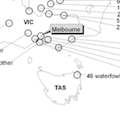Abstract
We investigated carriage of avian influenza viruses by wild birds in Australia, 2005–2008, to assess the risks to poultry industries and human health. We collected 21,858 (7,357 cloacal, 14,501 fecal) samples and detected 300 viruses, representing a detection rate of ≈1.4%. Rates were highest in autumn (March–May) and differed substantially between bird types, areas, and years. We typed 107 avian influenza viruses and identified 19 H5, 8 H7, and 16 H9 (40% of typed viruses). All were of low pathogenicity. These viruses formed clearly different phylogenetic clades to lineages from Eurasia or North America, suggesting the potential existence of Australian lineages. H7 viruses were similar to highly pathogenic H7 strains that caused outbreaks in poultry in Australia. Several periods of increased detection rates (numbers or subtypes of viruses) were identified. This study demonstrates the need for ongoing surveillance to detect emerging pathogenic strains and facilitate prevention of outbreaks.
